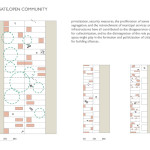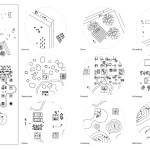As professor Simon Schama had pointed out, Kinderspelen or ‘children’s play’, represented in readily recognizable urban settings, has formed a topos of Netherlandish painting and Northern Humanist culture in general that goes back to at least the sixteenth century. By situating the games not in the imaginary vacuum of time and space but in topographically meaningful setting, nearly always with some public building, a town hall or guildhall, they evoke the civic and public virtues to which the child should be led. So the site is not only a place for children to play with other children, but also a place for them to explore the society.
The project will be an incremental, playful, participatory intervention. There are about 150 concrete slabs (2mx2m) on the site. Need to rearrange these slabs to create 25 platforms to define the space. Use simple natural elements and recycled material from Housing Corporation and residents to offer these concrete platforms different textures and characters. This minor-cost method tends to provide basic attraction to people and help residents to perceive the sensitive natural beauty that they can find in New West.
The reason to create the 25 platforms in advance and layout in grid is to send a clear signal to residents the intervention will be predictable and constant. Some facilities such as large question mark composed by beer crates and information board made by abandoned furniture further emphasis the signal that residents are encouraged to transform the places according to their will. Just do it!
The simple on-site workshop is the start point of the intervention; it is able for residents to make more things with the help of skilled workers. It is also the place where people discuss and make decision. Start with basic facility for service, promotion and play as examples to imply what people may be able to do here. And they also provide basic support. In order to make decision and work together, residents who are interested in the project needs to organize in form of group or a club. It can be imagined that there will be arguments about what to do and how to do. However we can see arguments as a way of democracy and interaction.
And the arguments can turn to a playing with arguments that enhance togetherness. For Sharon Zukin, it helps the modern consumer to think like a craftsman, to more or less get some of the production knowledge that earlier generations commanded. For Richard Sennett, the citizen-as-craftsman will be willing to make some effort to find out how the world around them works. So it is also a place for reflection.
As a game and intervention, at the beginning of each month, ideas from the residents will be discussed, and be added to catalogue. And at the end of each month, one “part” is created by residents. However, in any month, we can say the “whole” is already here. The added characters are simply to make the site more wonderful instead of complete the project.
During this period, the intervention provides a playground that residents can practice their abilities of decision making and organization, the residents are hoped to take charge most of the affairs by themselves. When the site becomes popular and the residents group has more power, more things then become possible. For example, slightly transform the landscape to create some pool, mini beach and mound.
Member of the club can get it free if they keep their plot in good condition and help to maintain the nearby green areas. Residents can also create facilities that they need, incrementally ‘occupy’ and improve the surrounding area. In fact, the mixed facilities make it possible for these different activities to be interwoven together and to enhance each other. For example, the outcome of the urban agriculture can be used to hold interpersonal or community events. The people who are growing things also attract the children playing around to try. When children play together, their parents are more easily to traverse the boundaries to form a cross-cultural interaction.
In sum, the place is for people to explore, to play, to learn together, and in doing so, togetherness appears. It is hoped that the place can be a mental and emotional anchor for people who live in a frequently changing, flexible, liquid and anxious modern society.

